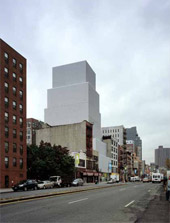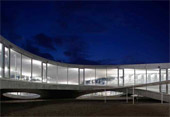Kazuyo Sejima & Ryue Nishizawa
Dear ladies and gentlemen, it is a great honor for us to be invited to this wonderful place. We are extremely delighted to be here with you tonight.
We would like to sincerely thank the Pritzker family, especially Mrs. Cindy Pritzker and Tom and Margot Pritzker. Thank you also to the Hyatt Foundation. To the members of the jury, thank you for selecting us. To our dear clients, thank you for giving us the opportunity to think and to realize our works. We would also like to thank all of our staff over the years, together with whom we have gone through many good and hard times. Thank you to all of the consultants and engineers who were involved in our projects—we have been deeply inspired by your expertise and passion. We are overwhelmed with our gratitude to all of you.
We would also like to take this moment to thank two special people in particular: Mr. Mutsuro Sasaki, who is here with us tonight, and Mr. Toyo Ito.
Throughout the years, Mr. Sasaki has been influential in many of our projects for structural planning and almost all of our designs have been realized together with him. Our collaboration cannot be described simply as a business relationship where he calculates the structure and we make the design. It is much more a union of creative visions through which he has helped us to see infinite possibilities. Without Mr. Sasaki, our architecture might have developed into something completely different. So we would like to thank you very much, Mr. Sasaki. We greatly appreciate everything that you have done for us.
As you know, Mr. Toyo Ito has been an immensely influential figure for both of us since we first entered into the world of architecture. Once again, we would like to express our deepest appreciation and respect for Mr. Ito. His wonderful works, words, and critiques have given us direction, which has affected us in immeasurable ways in the past and this will no doubt continue in our future. Words are not enough to express our gratitude and great admiration for Mr. Ito.
It has been fifteen years since we founded an architecture studio called SANAA. Back then, we did not imagine working on so many projects around the world and we did not even dream of standing here tonight to receive such an honor. The reason we started SANAA was because of a competition for an extension at the Museum of Contemporary Art in Sydney, Australia. Since it was our first opportunity to work on an international project, and it being the largest-scale project for the firm until that time, we thought it would be fun to form a team and did so in a rather light-hearted manner. The project was never realized, but together as SANAA, we won competitions for a theater in Almere, Holland, and a museum in Kanazawa, Japan. SANAA continues to exist today because we had the great fortune of working on projects like these.
As we continued, through trial and error, our direction, interests, and passions became clearer as we continued. Looking back, one of the major projects that defined our direction was the design for the 21st Century Museum of Contemporary Art in Kanazawa. This is a museum positioned in the very center of the city. We began with the concept of an “open” museum so that it is not only for art experts but also for the people of the city, who do not necessarily have a professional connection with art. We proposed a museum without a front or back so that people can enter freely from any direction. We also thought carefully about its effect on the surroundings and the relationship of the building with its context, because of the historical background of the region. When the building was completed and we saw that people enjoyed using the museum, we truly realized how wonderful it is for architecture to be “open.” A great deal of our aims became more obvious to us because of this museum; therefore we would like to express our gratitude to the museum, Kanazawa city, the mayor, and the people of Kanazawa for this great opportunity.
Since then, we have been involved in the project for The Toledo Museum of Art Glass Pavilion in Ohio, and here in New York, we were given a fantastic chance to design the New Museum of Contemporary Art. In this project, we wanted to create a building that relates closely to the dynamics of Bowery Street and echoes the philosophy of the museum. The building accommodates the program vertically and has become rather tall because of the limited size of the site. Despite its height, the museum aimed to absorb and respond to the activities of New Yorkers and the animated atmosphere of the city.
The Rolex Learning Center at the Ecole Polytechnique Fédérale de Lausanne (“EPFL”), which opened this year, is a building with a three-dimensional spatial composition. One large room undulates up-and-down and the building itself becomes a landscape whose topography provides various kinds of spaces. Again, our aim was to produce a building that is open to the people and creates different environments. The ideas we had been thinking about since the museum in Kanazawa developed to become a more organic and three-dimensional building.
As well as running the SANAA studio together, we both simultaneously lead our own individual architectural offices. So, there are three studios in total working together, all under one roof—which sounds rather confusing. SANAA works mainly on international projects and competitions and our individual firms work on friends’ houses and private galleries. There are exceptions but it basically works like this. People often ask us why we work in such a complicated way or criticize that it is confusing or does not look very efficient. But we continue to work like this because we like working this way. In the individual firms, we each think about architecture on our own and struggle with our own ideas. At the same time, we inspire and critique each other at SANAA. We believe working this way opens up many possibilities for both of us. The fact that we have both been awarded the prize gives us so much confidence and we are very happy and truly touched. Again, thank you very much.
We understand this award is not only in recognition of our past works but rather an encouragement toward new architectural creations. Our aim is to make better, innovative architecture and we will continue to put forth our best effort to do so.
Thank you very much.

